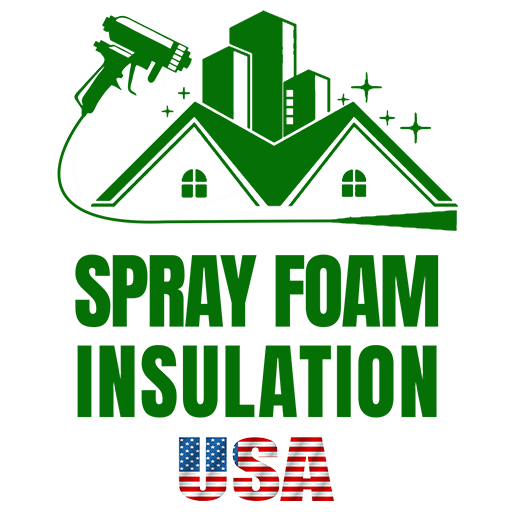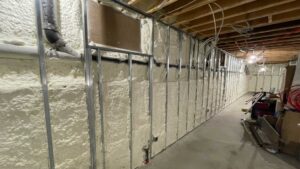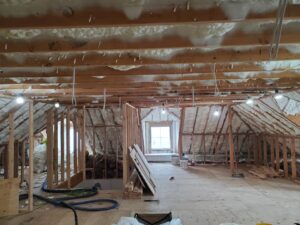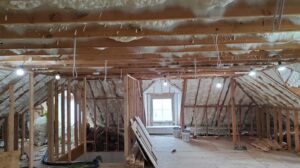Introduction
When it comes to maintaining a comfortable home temperature year-round and ensuring energy efficiency, attic insulation plays a pivotal role. It’s like wrapping your home in a cozy blanket; when done right, attic insulation keeps the warmth in during the cold winters and out during the hot summers. This not only leads to a more consistently comfortable living environment but also translates into significant savings on energy bills.
Upgrading your attic’s insulation is a critical step toward achieving these goals, especially for homeowners and business owners in New York and New Jersey, where the weather can range from bitterly cold to uncomfortably hot. Proper insulation not only helps you save money and enjoy a more consistent indoor temperature, but it also contributes to a greener planet by reducing energy consumption.
In simple terms, if you’re eyeing a snug home during winter and a cool one in summer without breaking the bank, investing in the right attic insulation is the way to go.

Understanding Attic Insulation
When we talk about making your home more energy-efficient and comfortable, attic insulation plays a starring role. Let’s break it down into bite-sized pieces: the types of insulation, what R-value means, and the materials commonly used.
Types of Insulation
There are several types of attic insulation, each with its own set of pros and cons. Here’s a quick rundown:
-
Fiberglass Batt Insulation: Picture big, fluffy, pink or yellow blankets. Easy to handle and great for DIY projects.
-
Blown-In Fiberglass Insulation: Tiny glass fibers are blown into attic spaces, filling nooks and crannies. It’s quick and covers more area effectively.
-
Blown-In Cellulose: Made from recycled paper products, it’s eco-friendly and has a higher R-value than some alternatives.
-
Spray Foam Insulation: This is a high-performance option that expands to fill gaps, providing excellent air sealing and moisture control.
R-value Significance
R-value is like a superhero cape for insulation. It measures how well insulation can resist heat flow. The higher the R-value, the better it keeps your home warm in winter and cool in summer. Different climates need different R-values to be effective. For example, a chilly northern climate requires a higher R-value insulation compared to a warmer southern area.
Insulation Materials
-
Fiberglass: Made from fine glass fibers, it’s available in batts or as loose-fill. It’s lightweight and easy to install, making it a popular choice for many homeowners.
-
Cellulose: This is a green option, made from recycled newspaper and treated with fire retardants. It’s denser than fiberglass, offering a higher R-value per inch.
-
Spray Foam: A chemical product that expands into a thick, hard foam. It offers excellent air sealing and moisture protection, along with a high R-value.
Understanding these basics will help you make an informed decision about the best attic insulation for your home. The goal is to enhance energy efficiency, improve comfort, and potentially save money on energy bills. Choosing the right type and material for your specific needs is key.
Evaluating Your Current Attic Insulation
Before you can upgrade, you need to know what you’re working with. Evaluating your current attic insulation is a crucial step. Here’s how to do it, broken down into simple, actionable steps.
Inspecting Insulation
Grab a flashlight and head up to your attic. Look around. What do you see? If you spot any areas where insulation is missing, damaged, or looks wet, take note. These are signs your insulation isn’t doing its job.
Measuring Thickness
Next, grab a ruler or a tape measure. Gently press it down into the insulation until you hit the attic floor. Write down the measurement. This tells you how thick your insulation is, which is a big clue about its effectiveness.
Identifying Insulation Type
Now, let’s figure out what kind of insulation you have. Here’s a quick guide:
-
Loose Fibers: If it’s fluffy and comes in yellow, pink, or white, it’s likely fiberglass. Depth times 2.5 equals the R-value.
-
Dense Gray or Near White with Black Specs: This is probably rock wool. Multiply the depth by 2.8 for the R-value.
-
Small Gray Flat Pieces or Fibers: Looks like shredded newsprint? That’s cellulose. Its R-value is the depth times 3.7.
-
Granules: Light-weight vermiculite or perlite will have an R-value of the depth times 2.7.
-
Batts: If you see large, rolled-up sheets of light-weight material in yellow, pink, or white, it’s fiberglass batts. The R-value here is the depth times 3.2.

Understanding these basics will help you assess whether your current attic insulation measures up. If it’s old, damaged, or just not thick enough, it’s time for an upgrade. The right insulation for your attic will depend on your climate, the age of your home, and your energy-saving goals.
With this information in hand, you’re ready to move on to choosing the right insulation for your attic, considering factors like material, R-value, and whether to DIY or bring in a professional. The goal is to enhance energy efficiency, improve comfort, and potentially save money on energy bills. Choosing the right type and material for your specific needs is key.
Choosing the Right Insulation for Your Attic
When it’s time to upgrade your attic insulation, the choices can feel overwhelming. But don’t worry, we’re here to break it down into simple terms. Let’s dive into attic insulation, comparing Fiberglass, Cellulose, and Spray Foam. We’ll look at their pros and cons, and what you need to consider based on your climate.
Fiberglass Batt Insulation
Pros:
– Eco-Friendly: Made from sand and recycled glass, making it a greener choice.
– Soundproof: Helps in reducing noise from outside.
– Installation Ease: Many homeowners find DIY installation straightforward, saving on costs.
Cons:
– Moisture Sensitivity: Can absorb moisture, leading to a decrease in effectiveness and potential mold issues.
– Risk of Injury: Handling fiberglass requires protective gear to avoid irritation or harm.
Climate Considerations: Works well in most climates, but areas with high humidity might present challenges due to moisture absorption.
Blown-In Fiberglass Insulation
Pros:
– Energy Efficiency: Provides a tight air seal, reducing energy costs.
– Quick Installation: Blowing the insulation into place is fast, making it a time-efficient choice.
– Air-tight Sealing: Excellent at filling gaps and cracks for an air-tight attic.
Cons:
– Settling Over Time: May decrease in effectiveness as the material settles.
– Maintenance: Might require more upkeep compared to other options.
Climate Considerations: A solid choice for varied climates, particularly effective in sealing air leaks in colder areas.
Blown-In Cellulose
Pros:
– Recycled Materials: Made from recycled paper, offering an eco-friendly insulation option.
– Higher R-Value: Typically provides better insulation per inch than fiberglass.
– Wind-Washing Reduction: Less prone to wind-washing effects, maintaining its effectiveness.
Cons:
– Moisture Sensitivity: Like fiberglass, can be prone to moisture issues.
– Added Chemicals: The fire retardants added to cellulose can raise environmental and health concerns.
Climate Considerations: Great for colder climates due to its higher R-value, but care should be taken in humid areas to prevent moisture absorption.
Spray Foam Insulation
Pros:
– Long-term Performance: Does not settle or degrade over time, maintaining its effectiveness.
– Structural Support: Adds strength to the building structure.
– High R-Value: Provides superior insulation with a higher R-value per inch than most alternatives.
– Energy Savings: Creates a comprehensive air seal, leading to significant energy savings.
– Moisture Barrier: Acts as a formidable moisture barrier, protecting against mold and water damage.
Cons:
– Cost: Generally more expensive upfront than other types of insulation.
– Professional Installation: Requires professional installation, which can add to the cost.
Climate Considerations: Ideal for both hot and cold climates due to its exceptional air sealing and moisture barrier properties.
Choosing the right attic insulation boils down to your specific needs, budget, and the climate you live in. Whether you opt for the eco-friendly and soundproof benefits of fiberglass batts, the quick and efficient air sealing of blown-in fiberglass, the high R-value and recycled content of cellulose, or the long-term performance and superior insulation of spray foam, make sure it aligns with your goals for energy efficiency, comfort, and sustainability.
Next, we’ll explore the benefits of spray foam insulation in more detail, highlighting why it’s a top choice for many homeowners looking to upgrade their attic insulation with Spray Foam Insulation USA.
Step-by-Step Guide to Upgrading Attic Insulation
Upgrading your attic insulation is a game-changer for both your home’s comfort and energy bills. Here’s how you can do it in just 5 easy steps.
1. Sealing Air Leaks
Before adding new insulation, it’s crucial to seal any air leaks. These leaks let warm air escape in the winter and enter in the summer, making your HVAC system work harder.
- Find the Leaks: Common spots include around light fixtures, at the top of interior walls, and where wires or pipes go through the ceiling.
- Seal Them Up: Use caulk for small gaps and expanding foam for larger spaces. Don’t forget the attic hatch or door!
2. Choosing Insulation Material
Next, decide on the type of insulation. Each type has its pros and cons.
- Fiberglass Batt Insulation is eco-friendly and easy to install yourself. It’s also soundproof.
- Blown-In Fiberglass Insulation offers excellent energy efficiency and fills the attic better, ensuring an air-tight seal.
- Blown-In Cellulose is made from recycled materials and has a higher R-value, reducing wind-washing.
- Spray Foam Insulation provides long-term performance, adds structural support, and has a high R-value.
3. Professional vs. DIY Installation
Now, decide whether to hire a pro or do it yourself.
- DIY: If you’re comfortable moving around in your attic and handling the installation, DIY can save you money. Just make sure you have the right safety gear and tools.
- Professional: For those who prefer not to crawl around in attics or deal with the nitty-gritty of insulation, hiring a professional is the way to go. They can handle everything quickly and efficiently.
4. Prepare Your Attic
Whether you’re going DIY or hiring help, your attic needs to be ready.
- Clear the Space: Remove any stored items and provide clear access to the areas needing insulation.
- Check Ventilation: Ensure your attic has proper ventilation. This helps prevent moisture buildup, which can lead to mold.
5. Installation
- DIY Installation: Follow the manufacturer’s instructions carefully. Wear protective clothing, and don’t forget to evenly distribute the insulation.
- Professional Installation: A professional will assess your attic, prepare the space, and install the insulation. They’ll also take care of any tricky spots and ensure everything is up to code.
Upgrading your attic insulation can seem like a big task, but breaking it down into these steps makes it manageable. Whether you choose to DIY or hire a professional, the important thing is to ensure your attic is well-insulated and sealed. This will lead to significant energy savings and a more comfortable home year-round.
Next, let’s delve into the many benefits of choosing spray foam insulation with Spray Foam Insulation USA, and why it could be the best choice for your attic upgrade.
About the Benefits of Spray Foam Insulation
When it comes to upgrading your attic insulation, spray foam stands out as a top contender. Its benefits extend far beyond the basics of insulation, offering a comprehensive solution for energy efficiency, longevity, and more. Let’s explore why Spray Foam Insulation USA recommends spray foam for your attic.
Energy Savings
Spray foam insulation is a powerhouse in reducing energy bills. With an impressive R-value between 5.6 and 8.0, it effectively minimizes heat transfer. This means your heating and cooling systems don’t have to work as hard, leading to significant energy savings. In fact, some homeowners have reported up to 35% savings on their energy bills!
Longevity
One of the standout features of spray foam is its durability. Unlike other insulation types that may sag or settle over time, spray foam maintains its effectiveness for years. It’s a long-term investment that pays off by avoiding the need for frequent replacements or upgrades.
Air Sealing
Creating an airtight seal is crucial in maximizing insulation efficiency. Spray foam uniquely adheres to surfaces, filling gaps and cracks that other insulation types might miss. This air sealing capability not only improves energy efficiency but also contributes to a more consistent indoor temperature.
Moisture Barrier
Moisture can be a home’s worst enemy, leading to mold, mildew, and structural damage. Spray foam insulation acts as a formidable moisture barrier, protecting your attic and home from potential water damage. Its ability to repel water helps maintain the integrity of your home’s structure and indoor air quality.
Spray Foam Insulation USA
Choosing Spray Foam Insulation USA for your attic upgrade means partnering with experts who understand the unique benefits of spray foam. With a focus on quality, efficiency, and customer satisfaction, Spray Foam Insulation USA ensures your attic is not just insulated but transformed into a more energy-efficient, comfortable, and protected space.
In conclusion, spray foam insulation from Spray Foam Insulation USA offers a comprehensive solution for homeowners looking to enhance their attic’s efficiency and overall home comfort. Its unmatched energy savings, longevity, air sealing capabilities, and moisture barrier properties make it an excellent choice for those seeking to upgrade their attic insulation.
Next, we’ll tackle some of the most frequently asked questions about attic insulation to help you make the most informed decision for your home.
Frequently Asked Questions about Attic Insulation
When it comes to attic insulation, there are a few questions that pop up more often than others. Let’s dive into those and provide some straightforward answers.
What type of insulation is best for attic?
The best type of insulation for your attic depends on several factors, including your climate, home design, and budget. However, spray foam insulation stands out due to its high R-value, air sealing capabilities, and moisture resistance. It’s particularly effective in creating an energy-efficient home by filling in gaps and cracks that other insulation types might miss.
How many inches of insulation should be in your attic?
The amount of insulation your attic needs can vary based on where you live. Generally, aiming for an R-value between R-30 and R-60 is recommended for most regions. In terms of inches, this could mean anywhere from 10 to 20 inches of insulation, depending on the material. Spray foam insulation might require less thickness to achieve the same R-value compared to traditional materials due to its superior insulating properties.
Is it worth adding more insulation to my attic?
Absolutely. Adding more insulation to your attic can lead to significant energy savings by maintaining your home’s temperature more effectively. This means your heating and cooling systems don’t have to work as hard, leading to lower utility bills. Moreover, improving your attic insulation can enhance indoor comfort, reduce noise from outside, and even increase your home’s resale value.
The key to maximizing the benefits of attic insulation is not just the type or amount but ensuring it’s properly installed. Spray Foam Insulation USA specializes in providing high-quality, professionally installed spray foam insulation that caters to your specific needs, ensuring you enjoy enhanced home comfort and energy efficiency.
Remember that investing in good attic insulation is not just about immediate benefits. It’s about creating a more comfortable, energy-efficient home that stands the test of time.
Conclusion
Energy Savings
Upgrading your attic insulation, especially with spray foam, is like putting a warm blanket around your home. It keeps the heat where you want it – inside during winter and outside during summer. This means your heating and cooling systems don’t have to work overtime, which can lead to significant energy savings. Our customers often report seeing a noticeable decrease in their energy bills after upgrading to spray foam insulation.
Home Comfort
A well-insulated attic contributes to a more consistent temperature throughout your home. No more hot or cold spots in different rooms—just smooth, even comfort wherever you are. Spray foam insulation also adds to this comfort by creating a seal against air leaks, ensuring that your home’s temperature is steady and predictable. Imagine living in a home that feels just right, every day, regardless of the weather outside. That’s the promise of quality attic insulation.
Spray Foam Insulation USA
At Spray Foam Insulation USA, we’re committed to helping you achieve a more energy-efficient and comfortable home. Our spray foam solutions are designed to meet the unique challenges of homes in New York and New Jersey, providing superior insulation and air sealing that stand up to our diverse weather conditions.
Choosing us means opting for a service that values your comfort and savings. Our expert team is ready to guide you through the process, ensuring that your attic insulation upgrade is smooth and hassle-free. From the initial assessment to the final installation, we’re with you every step of the way.
In conclusion, upgrading your attic insulation with Spray Foam Insulation USA is a smart investment in your home’s future. Not only will you enjoy immediate benefits like energy savings and improved comfort, but you’re also enhancing your home’s value and contributing to a healthier environment. Let’s take the first step together towards a more energy-efficient and comfortable home. Contact us today to learn more about how we can help you achieve the perfect indoor climate.





